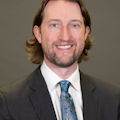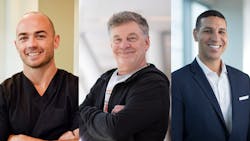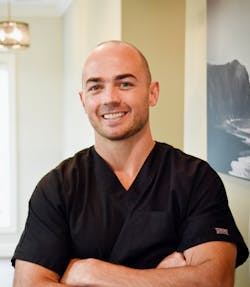Turning the tide: An interview with 3 dentists who rebounded in 2020 and are poised for success in 2021
When the the COVID-19 pandemic escalated in March, it sent shockwaves through nearly every aspect of everyday life. For dental professionals, there were no exceptions. This meant rethinking the entire patient experience, reevaluating clinical delivery systems, and revisiting basic principles of infection control and universal precautions. But now that some time has passed, we're beginning to understand why some dental practices were able to successfully adapt to COVID-19's challenges and make sustainable long-term improvements. To find out how these practices were able to change quickly and intelligently, we talked to three dentists who managed to rebound in 2020 and who now have high hopes for a prosperous 2021.
Here we interview Kent McBride, DDS, a founding partner at Meridian Dental Specialists in Morgantown, West Virginia, whose practice specializes in endodontics and periodontics; Gregory Shubat, DDS, of Grove Dental Associates, a dental group with four locations near Chicago; and Andrew Matta, DMD, of Refresh Dental in New Castle, Pennsylvania. All three are members of the North American Dental Group (NADG), a dental support organization with 240-plus practices across 15 states, of which Dr. Matta is cofounder and chief medical officer.
Read on to learn more about Dr. McBride and Dr. Shubat's unique perspectives on the changing practice of dentistry, as well as commentary from Dr. Matta on how NADG is navigating the pandemic's challenges on a larger scale.
Interview with Dr. Kent McBride, Dr. Gregory Shubat, and NAGD cofounder Dr. Andrew Matta
DIQ: The COVID-19 pandemic has required dentists to become leaders in the health-care community. When you think back to the early days of the pandemic—from the initial outbreak to the shutdown of dental practices—what were some of the key decisions you made that set you up for success later on? For example, how did you confidently make decisions and explore new protocols as guidances from government agencies and professional associations were evolving?
- It gave our teams the confidence that we will err on the side of caution when our safety is at risk.
- Our doctors had more time to be involved in researching proper PPE, creating guidelines and handling HR concerns.
- We were able to “tighten up” other parts of our practice that needed attention. We created work groups to put some great new systems in place to help our business come out stronger on the other side.
The shutdown made us furlough most of our team, but we couldn’t abandon our patients. We moved from four locations to only one being open to treat dental emergencies. Our new goal was to try to keep dental patients out of hospital emergency departments. The emergency dental clinic was staffed by volunteers—true heroes because early in the pandemic, not a lot was known about COVID-19. There was a risk and yet dentistry dove right in to provide needed oral care to patients regardless of the risk. These providers are to be commended.
Thankfully, we are affiliated with NADG, which offered invaluable support and guidance on how to safely treat patients and protect both patients and our team members. They monitored and worked closely with government agencies such as the Centers for Disease Control and Prevention, Department of Health, the American Dental Association (ADA) and local dental societies to help develop PPE recommendations, as well as standard operating procedures for dental visits.
NADG’s approach went above and beyond some early recommendations to ensure safety. I believe the ADA even adopted some of these protocols when developing their recommendations for delivery of safe dental care. NADG should be applauded for its rapid, thoughtful, science-based response.
DIQ: Can you talk generally about the unique challenges your practices faced regarding the pandemic? Also, can you give an example of how you creatively overcame one of those challenges? For example, was there a particular pain point in the patient journey that you found a solution to? Or perhaps there was a clinical challenge or infection control issue that required you to rethink your approach to treatment?
Dr. McBride: Especially early on, the shutdown created significant anxiety for our team members and doctors—both those who were furloughed and those who continued to treat patients. We knew many of our team members would face financial and emotional difficulty. Taking care of our own was of utmost importance, so we took decisive action:
- Our partners pitched in to create a relief fund for those who needed financial help during the hard times. We are proud that this fund will continue through the pandemic and well beyond.
- We created a Doctor Aid Package to give our newer doctors monthly income through the pandemic via a forgivable loan, provided they stayed with the group for 12 months.
- We hosted optional virtual happy hours each week. Our teams really enjoyed the ability to stay connected, hear from those of us on the front lines of this crisis, and ask questions about the most recent COVID-19 developments.
Dr. Shubat: Oral health is a major component of total health. During the shutdown, patients exhibiting comorbidities needed to be seen, but due to restrictions, could not be seen. When restrictions were lifted, it created a large backlog of patients needing care. Adding to the backlog was a need to lengthen appointments to accommodate patient intake, as well as the donning and removing of PPE and disinfecting of treatment rooms between patients. In order to serve these patients, hours were extended, including the opening of some dental offices on Sundays.
Dr. Matta: Without question, the COVID-19 pandemic has caused incredible challenges for the dental industry. Our top priority was, and still remains, the safety of our patients and team members. The new safety protocols that were put in place—including head-to-toe PPE and screening of all team members when they arrive for work and every patient when they arrive for an appointment—are exhaustive but necessary new measures that have forever changed dentistry.
As a dental support organization, we’ve been able to expand our business by helping dentists who sought to utilize our services, while in turn lending their clinical expertise that helps us deliver best-in-class oral care across our company. We’re very fortunate to have so many doctors invest their trust in NADG and become part of a growing company grounded in our servant leadership culture and mindset.
DIQ: Could you talk about how COVID-19 has affected your practice financially and what steps you have taken to secure the health of your business?
Dr. McBride: Since our group is primarily endodontists delivering emergency care, we were fortunate to still be able to help enough patients to keep the lights on. We became more aware of our costs and made sure to run a lean and mean operation. We were able to work with some of our incredibly understanding vendors and landlords to defer payments, which helped significantly.
Dr. Shubat: The financial impact the pandemic has had on dentistry is not yet fully understood. Obviously, offices were closed but there are also other effects that can be attributed to COVID-19. Loss of staff, both clinical and clerical, has been one of the biggest challenges. Teams are working short-staffed. Position placement ads need to be run, interviews need to be conducted, and training needs to occur. All of these require resources, both human and monetary, at a time when offices are already stretched thin.
Let’s not forget the new costs to cover enhanced PPE, disinfecting procedures, and any other procedures and protocols that were not being done prior to the pandemic. Despite these concerns, I am encouraged by how quickly dentistry has rebounded, not to pre-COVID-19 parameters but certainly much better than I expected.
Dr. Matta: The pandemic has had a tremendous impact on the dental industry and our company was not spared. When the pandemic led to a government-mandated shutdown of non-essential businesses and services, we were forced to temporarily close 80% of NADG-supported dental practices. The remaining 20% stayed open to serve critical dental needs. So, some dental practices have been affected more than others.
But we used the time during the shutdown to develop new safety protocols that at the time were above and beyond what was recommended by the Centers for Disease Control and Prevention and the American Dental Association (ADA). And given the extreme threat this public health crisis posed, we shared this information with other dental offices and DSOs in hopes of slowing the spread of the coronavirus.
This commitment to safety enabled us to reopen and return to delivering routine oral care and elective procedures. We were sure to convey all these messages both to our team members and patients. As we close 2020, we’re happy to see that oral care activity has returned to prepandemic levels at many of our practices.
DIQ: What are you doing to overcome a COVID-19 second wave?
Dr. McBride: Now that we know more about the virus, testing is readily available, and we have plenty of PPE, we feel adequately prepared for a second wave. We have guidelines in place should we have cases in our offices and will be able to quickly defer patients to a nearby office should we need to shut down a location. Pandemic fatigue is a real thing, so we are doing everything we can to keep our teams consistent with mask-wearing, disinfection, and distancing. This is probably way more important now than it was back in March and April.
Dr. Shubat: Unfortunately, COVID-19 cases are on the rise again and more restrictions could be on the horizon. I feel dentistry has proven it can safely care for patients during the pandemic and should be allowed to continue providing essential care.
The pandemic has caused everyone to hit the pause button. Now is the time to hit the reset button. Dentistry is a noble profession, one that I have been honored to part of for over 36 years.
Dr. Matta: Knowing that dentists and hygienists are still among the most vulnerable to coronavirus exposure, all supported dental practices will continue to follow the exhaustive new safety measures that NADG established earlier this year. From head-to-toe PPE for team members and enhanced infection control procedures with frequent cleaning and sanitizing, to comprehensive screenings and updated visit protocols for patients, these measures are designed to provide a safe environment that minimizes the risk for everyone.
DIQ: There has been a great deal of speculation as to how COVID-19 will affect the dental industry in the long term. What is your opinion about how COVID-19 will change dentistry after the pandemic subsides?
Dr. McBride: N-95 masks are probably here to stay and many OSHA requirements—that already were supposed to be in place, but let’s be honest, many offices were lax about them—will be put in practice regularly.
One exciting development our Meridian group initiated during the shutdown was creating a process for “real time specialty consults.” We think there is plenty of room for growth in our industry with regards to collaboration between general practitioners and specialists. We hope to lead this charge to advocate for patients and for the endodontic/periodontics communities nationwide.
I also believe more dental care per visit will become more common. Many offices implemented this during the pandemic to limit exposure and found that patients liked it better. Plus, it was more efficient from a business standpoint. This will probably increase the demand for dental anesthesiologists, and sedation dentistry will become more mainstream.
And hopefully dental dams will be used more consistently during endodontic procedures!
Dr. Shubat: We have proven that we can provide care safely to our patients. Our role as health-care providers demands that the dental profession move forward to improve the health of the general population. Along those lines, we should consider expanding our duties, such as providing on-site rapid COVID-19 testing for both patients and staff and vaccination delivery in order to reach more people sooner.
To broaden the reach of our care, teledentistry has grown and was redeveloped. The pandemic, along with closures, made dentists think more about providing care if in-person visits were not a possibility. While this is effective during the COVID-19 pandemic, the long-term benefit to patients will be tremendous. Rural areas and underserved areas can now be accessed from afar and treatment can be provided that may not have been as prevalent prior to the pandemic. It’s time for us to do whatever we can.
I am cautiously optimistic about the future of the dental profession. If we remain focused on caring and improving the health of our patients, we will continue to be the respected essential health care givers that our patients so rightfully deserve.
Dr. Matta: While both patients and team members have shared they feel safe returning to dental practices, NADG and its affiliated dentists recognize the dental industry faces an unpredictable outlook. Still, this pandemic has reminded us that dental care is essential health care, and NADG will continue to push to assure that it is recognized as such going forward.
Additionally, NADG will continue to highlight and reinforce that dentists are infectious disease control experts who can play a major role in helping the US combat COVID-19. NADG spearheaded the crusade to expand the scope of services so affiliated dentists could begin administering COVID-19 tests early in the pandemic.
And given our training and experience, dentists should also be considered among the providers who are able to safely administer vaccines, including the COVID-19 vaccine, because the dental setting is an ideal access point.
Editor's note: This article was updated on December 21, 2020, to include expanded commentary from Dr. Andrew Matta.
Recommended:
- How a 230-location DSO is planning to test all patients for COVID-19 and assist with follow-up care
- Dental patient survey shows 5 key shifts during COVID-19
- 5 factors to consider for post-COVID dentistry
Zachary Kulsrud is the group editorial director of Endeavor Business Media's dental group, publishers of Dental Economics, DentistryIQ, Perio-Implant Advisory, and RDH magazine.
About the Author

Zachary Kulsrud
Zachary Kulsrud is the editorial director for Endeavor Business Media's dental group, publishers of Dental Economics, DentistryIQ, Perio-Implant Advisory, and RDH magazine.
Updated July 7, 2020



